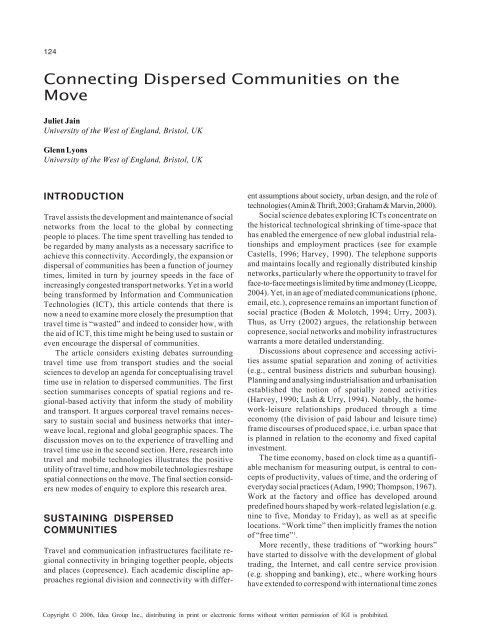Jain, J. and Lyons, G. (2005) Connecting dispersed communities on ...
Jain, J. and Lyons, G. (2005) Connecting dispersed communities on ...
Jain, J. and Lyons, G. (2005) Connecting dispersed communities on ...
Create successful ePaper yourself
Turn your PDF publications into a flip-book with our unique Google optimized e-Paper software.
124<br />
<str<strong>on</strong>g>C<strong>on</strong>necting</str<strong>on</strong>g> Dispersed Communities <strong>on</strong> the<br />
Move<br />
Juliet <str<strong>on</strong>g>Jain</str<strong>on</strong>g><br />
University of the West of Engl<str<strong>on</strong>g>and</str<strong>on</strong>g>, Bristol, UK<br />
Glenn <str<strong>on</strong>g>Ly<strong>on</strong>s</str<strong>on</strong>g><br />
University of the West of Engl<str<strong>on</strong>g>and</str<strong>on</strong>g>, Bristol, UK<br />
INTRODUCTION<br />
Travel assists the development <str<strong>on</strong>g>and</str<strong>on</strong>g> maintenance of social<br />
networks from the local to the global by c<strong>on</strong>necting<br />
people to places. The time spent travelling has tended to<br />
be regarded by many analysts as a necessary sacrifice to<br />
achieve this c<strong>on</strong>nectivity. Accordingly, the expansi<strong>on</strong> or<br />
dispersal of <str<strong>on</strong>g>communities</str<strong>on</strong>g> has been a functi<strong>on</strong> of journey<br />
times, limited in turn by journey speeds in the face of<br />
increasingly c<strong>on</strong>gested transport networks. Yet in a world<br />
being transformed by Informati<strong>on</strong> <str<strong>on</strong>g>and</str<strong>on</strong>g> Communicati<strong>on</strong><br />
Technologies (ICT), this article c<strong>on</strong>tends that there is<br />
now a need to examine more closely the presumpti<strong>on</strong> that<br />
travel time is “wasted” <str<strong>on</strong>g>and</str<strong>on</strong>g> indeed to c<strong>on</strong>sider how, with<br />
the aid of ICT, this time might be being used to sustain or<br />
even encourage the dispersal of <str<strong>on</strong>g>communities</str<strong>on</strong>g>.<br />
The article c<strong>on</strong>siders existing debates surrounding<br />
travel time use from transport studies <str<strong>on</strong>g>and</str<strong>on</strong>g> the social<br />
sciences to develop an agenda for c<strong>on</strong>ceptualising travel<br />
time use in relati<strong>on</strong> to <str<strong>on</strong>g>dispersed</str<strong>on</strong>g> <str<strong>on</strong>g>communities</str<strong>on</strong>g>. The first<br />
secti<strong>on</strong> summarises c<strong>on</strong>cepts of spatial regi<strong>on</strong>s <str<strong>on</strong>g>and</str<strong>on</strong>g> regi<strong>on</strong>al-based<br />
activity that inform the study of mobility<br />
<str<strong>on</strong>g>and</str<strong>on</strong>g> transport. It argues corporeal travel remains necessary<br />
to sustain social <str<strong>on</strong>g>and</str<strong>on</strong>g> business networks that interweave<br />
local, regi<strong>on</strong>al <str<strong>on</strong>g>and</str<strong>on</strong>g> global geographic spaces. The<br />
discussi<strong>on</strong> moves <strong>on</strong> to the experience of travelling <str<strong>on</strong>g>and</str<strong>on</strong>g><br />
travel time use in the sec<strong>on</strong>d secti<strong>on</strong>. Here, research into<br />
travel <str<strong>on</strong>g>and</str<strong>on</strong>g> mobile technologies illustrates the positive<br />
utility of travel time, <str<strong>on</strong>g>and</str<strong>on</strong>g> how mobile technologies reshape<br />
spatial c<strong>on</strong>necti<strong>on</strong>s <strong>on</strong> the move. The final secti<strong>on</strong> c<strong>on</strong>siders<br />
new modes of enquiry to explore this research area.<br />
SUSTAINING DISPERSED<br />
COMMUNITIES<br />
Travel <str<strong>on</strong>g>and</str<strong>on</strong>g> communicati<strong>on</strong> infrastructures facilitate regi<strong>on</strong>al<br />
c<strong>on</strong>nectivity in bringing together people, objects<br />
<str<strong>on</strong>g>and</str<strong>on</strong>g> places (copresence). Each academic discipline approaches<br />
regi<strong>on</strong>al divisi<strong>on</strong> <str<strong>on</strong>g>and</str<strong>on</strong>g> c<strong>on</strong>nectivity with differ-<br />
ent assumpti<strong>on</strong>s about society, urban design, <str<strong>on</strong>g>and</str<strong>on</strong>g> the role of<br />
technologies (Amin & Thrift, 2003; Graham & Marvin, 2000).<br />
Social science debates exploring ICTs c<strong>on</strong>centrate <strong>on</strong><br />
the historical technological shrinking of time-space that<br />
has enabled the emergence of new global industrial relati<strong>on</strong>ships<br />
<str<strong>on</strong>g>and</str<strong>on</strong>g> employment practices (see for example<br />
Castells, 1996; Harvey, 1990). The teleph<strong>on</strong>e supports<br />
<str<strong>on</strong>g>and</str<strong>on</strong>g> maintains locally <str<strong>on</strong>g>and</str<strong>on</strong>g> regi<strong>on</strong>ally distributed kinship<br />
networks, particularly where the opportunity to travel for<br />
face-to-face meetings is limited by time <str<strong>on</strong>g>and</str<strong>on</strong>g> m<strong>on</strong>ey (Licoppe,<br />
2004). Yet, in an age of mediated communicati<strong>on</strong>s (ph<strong>on</strong>e,<br />
email, etc.), copresence remains an important functi<strong>on</strong> of<br />
social practice (Boden & Molotch, 1994; Urry, 2003).<br />
Thus, as Urry (2002) argues, the relati<strong>on</strong>ship between<br />
copresence, social networks <str<strong>on</strong>g>and</str<strong>on</strong>g> mobility infrastructures<br />
warrants a more detailed underst<str<strong>on</strong>g>and</str<strong>on</strong>g>ing.<br />
Discussi<strong>on</strong>s about copresence <str<strong>on</strong>g>and</str<strong>on</strong>g> accessing activities<br />
assume spatial separati<strong>on</strong> <str<strong>on</strong>g>and</str<strong>on</strong>g> z<strong>on</strong>ing of activities<br />
(e.g., central business districts <str<strong>on</strong>g>and</str<strong>on</strong>g> suburban housing).<br />
Planning <str<strong>on</strong>g>and</str<strong>on</strong>g> analysing industrialisati<strong>on</strong> <str<strong>on</strong>g>and</str<strong>on</strong>g> urbanisati<strong>on</strong><br />
established the noti<strong>on</strong> of spatially z<strong>on</strong>ed activities<br />
(Harvey, 1990; Lash & Urry, 1994). Notably, the homework-leisure<br />
relati<strong>on</strong>ships produced through a time<br />
ec<strong>on</strong>omy (the divisi<strong>on</strong> of paid labour <str<strong>on</strong>g>and</str<strong>on</strong>g> leisure time)<br />
frame discourses of produced space, i.e. urban space that<br />
is planned in relati<strong>on</strong> to the ec<strong>on</strong>omy <str<strong>on</strong>g>and</str<strong>on</strong>g> fixed capital<br />
investment.<br />
The time ec<strong>on</strong>omy, based <strong>on</strong> clock time as a quantifiable<br />
mechanism for measuring output, is central to c<strong>on</strong>cepts<br />
of productivity, values of time, <str<strong>on</strong>g>and</str<strong>on</strong>g> the ordering of<br />
everyday social practices (Adam, 1990; Thomps<strong>on</strong>, 1967).<br />
Work at the factory <str<strong>on</strong>g>and</str<strong>on</strong>g> office has developed around<br />
predefined hours shaped by work-related legislati<strong>on</strong> (e.g.<br />
nine to five, M<strong>on</strong>day to Friday), as well as at specific<br />
locati<strong>on</strong>s. “Work time” then implicitly frames the noti<strong>on</strong><br />
of “free time” 1 .<br />
More recently, these traditi<strong>on</strong>s of “working hours”<br />
have started to dissolve with the development of global<br />
trading, the Internet, <str<strong>on</strong>g>and</str<strong>on</strong>g> call centre service provisi<strong>on</strong><br />
(e.g. shopping <str<strong>on</strong>g>and</str<strong>on</strong>g> banking), etc., where working hours<br />
have extended to corresp<strong>on</strong>d with internati<strong>on</strong>al time z<strong>on</strong>es<br />
Copyright © 2006, Idea Group Inc., distributing in print or electr<strong>on</strong>ic forms without written permissi<strong>on</strong> of IGI is prohibited.

















